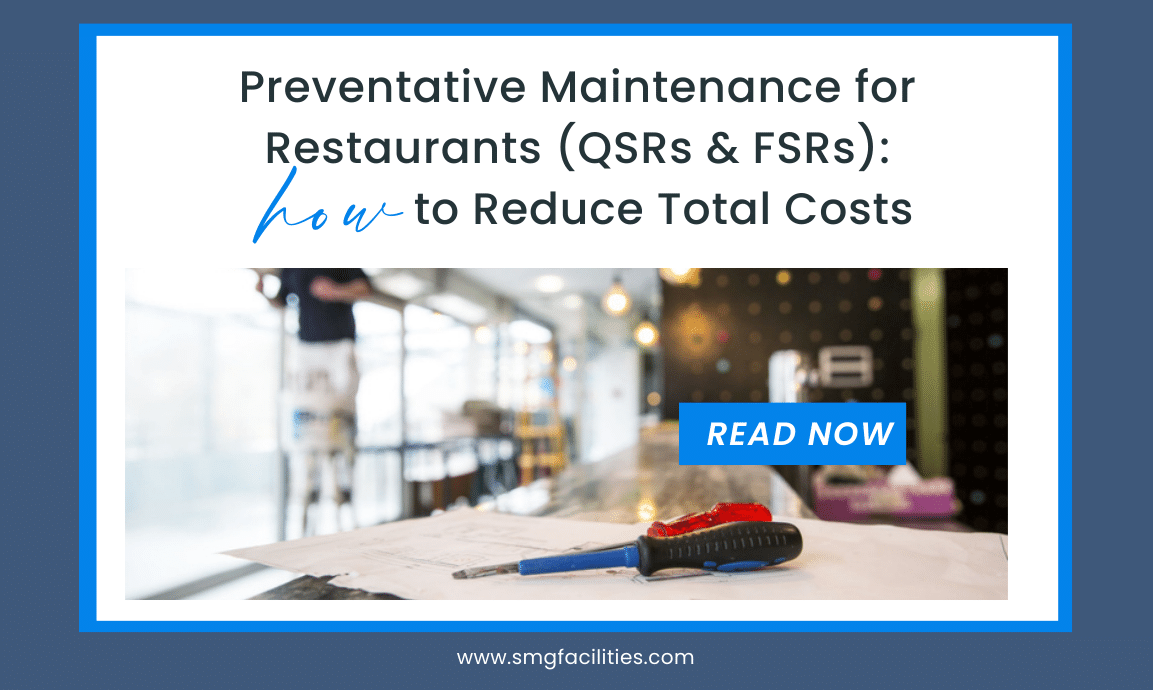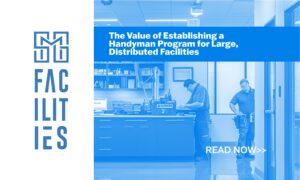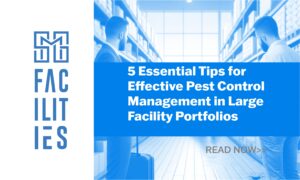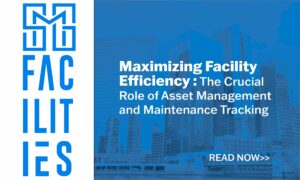Few places are busier than restaurants when the atmosphere is inviting, the food is delicious, and the people are hungry. But when an essential piece of kitchen equipment breaks down, the subsequent whirlwind of activity quite often comes crashing down swifter and louder than a copper pan falling off an overhead rack. And the hit to a restaurant’s profit margin usually adds another thud. There is no good time for a hot water heater, freezer, refrigerator, or range to go on the blink. But there certainly are bad times when it can happen — like when the place is full of famished patrons, or the drive-thru line is bumper-to-bumper around the building. To help reduce those frenzied moments from happening, here are two words to savor: preventative maintenance. This blog examines the vital role of preventative maintenance in restaurant management, how casual-dining, quick-service (QSR), and full-service (FSRs) restaurants can establish and leverage a maintenance schedule and kitchen equipment checklist to their fullest advantage, and how a partner like SMG Facilities can put together a preventative program that suits your needs.
What is Preventative Maintenance for Restaurants?
Prep is an essential and daily part of running a restaurant. If staff prepares certain food and their workspace ahead of time, the swift flow of creating and serving a meal goes much smoother. Think of preventative maintenance as prep. Like everything else involved in running a restaurant, you want to ensure your equipment is always ready. Preventative maintenance, which is a practice that restaurateurs use to inspect and care for equipment in advance to help reduce the chances of a breakdown, can be just as crucial as daily prep work. Preemptively ensuring kitchen equipment is working correctly and performing at its highest level can mean those “what are we going to do now” moments are much less likely to rear their ugly heads.
A preventative maintenance program in the food industry can cover the usual high-ticket kitchen equipment that comes to mind immediately — such as freezers, ovens, and food processors — but managers and staff should also check many other areas ahead of time. That list includes:
- Heating, venting, and air conditioning systems (HVAC)
- Grills
- Hot Water Heaters
- Appliances like mixers, slicers, and vacuum sealers
- Microwaves
- Ice machines
- Beverage dispensing units
- Coffee equipment
- Hood cleaning
- Grease traps
- Plumbing
- Fire suppression
- Commercial cleaning and sanitizing
- Facility exterior
- Pest control
Preventative vs. Recurring Maintenance for Restaurants
Preventative maintenance programs in the restaurant industry can take on more than one form. The intent is to keep kitchen equipment and other facets in excellent working order by checking and cleaning them periodically to ward off performance issues. That differs from recurring maintenance, which is often done on a daily or weekly schedule to make sure items are operating in a sanitary and safe order. Nightly cleaning, weekly pressure washing, and waste management are among the operations performed in recurring maintenance. Restaurants can face health code violations and poor reviews if they do not keep up with recurring maintenance. Preventative maintenance does help with keeping things safe and clean. Still, its emphasis is on ensuring the equipment is functioning at a high level and will continue to do so for an extended time.
Top 10 Tips for Preventative, Equipment, & Recurring Maintenance
If it wasn’t clear already, many forms of maintenance are central to operating a successful restaurant. To help you better understand the maintenance world, here are 10 tips that QSRs and FSRs can use to get a jump on maintenance.:
1. Become well-versed in manufacturer guidelines.
Many restauranteurs overlook this step in the maintenance process, but it should be one of the first things to tackle. Manufacturer guidelines can provide relevant information on how to care for and service your equipment. This knowledge will help you use the equipment to its full potential, save on what can be costly repairs, and extend the product’s lifespan. Using the guidelines, you can create a spreadsheet with the pertinent details to make it easier to quickly find how to care for the equipment, when is the suggested time to clean it, and if there are mileposts for changing or replacing parts.
2. Draw up a thorough maintenance schedule.
It may be time-consuming, but putting together a maintenance schedule that encompasses all the required care for each piece of equipment will eventually prove fruitful. It will be easy to track which machinery is next on the maintenance list and its service needs. Such an all-encompassing schedule can also ensure you don’t overlook the pieces that need quarterly or yearly maintenance amid the items that require daily, weekly, and monthly servicing.
3. Make sure to routinely clean and sanitize kitchen equipment.
This sometimes overlooked tip has a twofold effect on your restaurant. For one, it ensures the kitchen equipment is free of anything that can gum up its ability to function correctly. But it will also help reduce the possibility of harmful bacteria in your facility, creating a safer environment for customers and employees. Take the kitchen hood as an example. If it is not regularly looked after and cleaned, it can lead to two hazardous problems. Grease can gather in the hood mesh and become a fire hazard. The kitchen hood can also become a breeding ground for mildew and mold.
4. Set up periodic fire suppression checks.
Faulty kitchen equipment is often the root cause of commercial fires. To help reduce the chances of that at your restaurant, one of the best practices is to schedule a fire suppression inspection every three to six months. A qualified inspector will visit your facility and verify that things are in working order and that the overall venue upkeep is sufficient to reduce the risk of fire hazards. These periodic checks provide one more level of assurance that maintenance is doing its job.
5. Instruct team members on equipment handling and maintenance.
It is imperative that team members, especially new hires, are trained not only in how to use the equipment but also in how to maintain it daily. That training can have multiple benefits. If workers know how to use the equipment correctly, that can reduce any wear and tear from misuse. They might even recognize when equipment is not working as designed and alert someone in charge. With a knowledgeable person in charge of running it, a machine can run smoothly, which in turn helps the whole workflow of the restaurant be more efficient.
6. Spread out the responsibility.
Training staff on how to operate and maintain kitchen equipment is a great start, but managers should also take the time to delegate maintenance tasks to workers in each section — such as the front of the house (FOH) and back of the house (BOH). That approach will ensure that no one person is overwhelmed with maintenance tasks in addition to their daily chores. For a QSR, managers can assign shift-based duties on a rotational basis. Alternatively, FSR managers can assign tasks to positions or departments. In either case, managers must confirm and sign off on all completed maintenance tasks.
7. Hold monthly inspections.
To provide one more layer of maintenance alertness, perform monthly inspections to determine whether the equipment is running correctly or might need to be serviced by a technician. Essential items to look for include: grease build-up, clogged refrigeration air filters, loose wires, and leaky water valves. Noting these things on a monthly inspection and having them serviced before reaching a desperate and dangerous state will no doubt be less costly than an unexpected breakdown.
8. Keep on top of scheduling maintenance on high-use equipment.
When you know a piece of equipment in your restaurant is being used more regularly, like an air-conditioning unit or the ice cream dispenser during the summer in the desert, schedule more frequent inspections and upkeep. This approach will likely limit the risk of equipment failures and ensure systems and kitchen appliances can remain efficient with a tweak or two. In some cases, in-house staff can perform inspections and maintenance, while others might require regularly scheduled visits from an outside expert.
9. Track equipment servicing.
Time for a spreadsheet again. This time it can track all the pertinent service details on a piece of equipment: what, when, why, and the outcome. This level of detail will prove vital in the long run when discussing equipment depreciation and deciding whether to continue repairs or replace it.
10. Secure a pest-free zone.
Nothing can bring more bad publicity than insects or rodents in a restaurant. In the case of rodents, not only do they invite unsanitary conditions, but they can be destructive by doing things like chewing through electrical wires. So to counteract them, reach for prevention, sanitation, and inspection. The first step is to deter them from entering and hanging around. That means proper food storage practices and ensuring equipment and work areas are sanitary and sealed. Follow that up with regular inspections.
The Right Partner Can Help You Put Restaurant Preventative Maintenance into Action
For many, it’s as easy to wash over preventative maintenance as it is to wipe off a table. But this blog has turned the tables on that thinking and provided plenty of reasons why preventative maintenance can help restaurants avoid breakdowns, save money, and convey a better image while still providing diners with delicious dishes. Trying to handle all the tasks involved with preventative maintenance can seem as intimidating as a famous British chef whose kitchen is in Hades. But there is a way to climb out. By partnering with SMG Facilities, an integrated facilities management company since 1996 that specializes in preventative maintenance, restaurants can whip up a five-star plan and find more time to serve up success. To get a taste of what SMG can do for you, visit our website or contact us today to start a deeper conversation.





